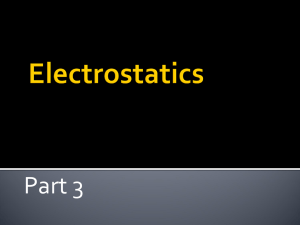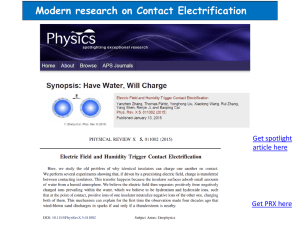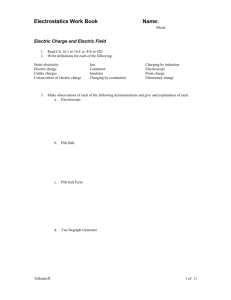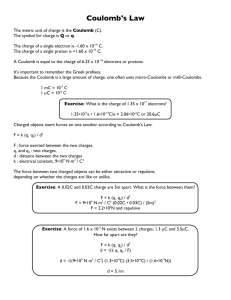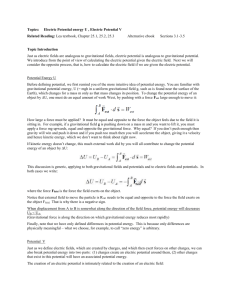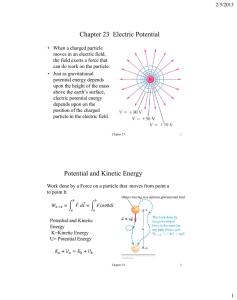Electric potential energy
advertisement
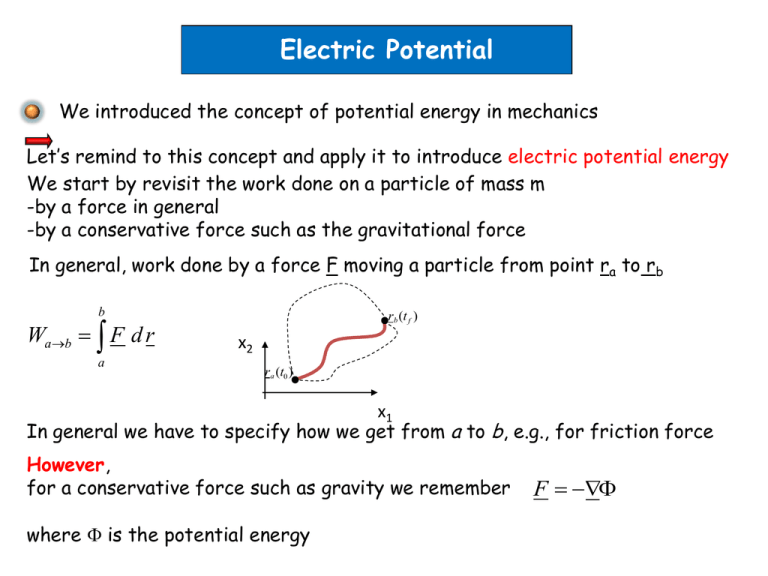
Electric Potential We introduced the concept of potential energy in mechanics Let’s remind to this concept and apply it to introduce electric potential energy We start by revisit the work done on a particle of mass m -by a force in general -by a conservative force such as the gravitational force In general, work done by a force F moving a particle from point ra to rb b Wab F d r a rb (t f ) x2 r a (t0 ) x1 In general we have to specify how we get from a to b, e.g., for friction force However, for a conservative force such as gravity we remember where is the potential energy F b With this we obtain Wab d r d a Gravity as an example b b a a Independent of the path between r b (t f ) and r a (t0 ) M Gravitational force derived from ( r ) G r h Pot. energy depends on h, not how to get there. Electric potential energy Can we find a function U =U (r) such that U ( r ) F is the force exerted by a point charge q on a test charge q0 ? We expect the answer to be yes, due to the similarity between Coulomb force and gravitational force F gravity m m0 G 2 rˆ r mm0 ( r ) G , / m0 r Potential Potential energy F Coulomb 1 qq0 rˆ 2 4 0 r Let’s try U ( r ) In fact we see F Coulomb 1 qq0 4 0 r dU U ( r ) rˆ dr 1 qq0 rˆ 2 4 0 r simple because of radial symmetry where U(r)=U(r) We conclude Electric potential energy of electrostatically interacting point charges q and q0 1 qq0 U (r) 4 0 r U U attractive potential qq0<0 repulsive potential qq0>0 r r As always, potential defined only up to an arbitrary constant. Expression above uses U(r)=0 as reference point We know already the superposition principle for electric fields and forces, can we find a net potential energy for F ( r ) F 1 ( r ) F 2 ( r ) F 3 ( r ) ... q0 interacting with several point charges? Force exerted on q0 by charge q3 at r3 Force exerted on q0 by charge q2 at r2 Force exerted on q0 by charge q1 at r1 Net force q0 experiences y 1 q1q0 F 1 ( r ) U1 ( r ) 4 r r 1 0 1 q2 q0 F 2 ( r ) U 2 ( r ) 4 r r 2 0 ... q1 Note: textbook on p. 785 defines ri r i r I prefer to keep r-dependence explicitly visible r1 r q0 r2 r3-r r3 q3 x q F ( r ) F 1 ( r ) F 2 ( r ) F 3 ( r ) ... U1 ( r ) U1 ( r ) 2 U1 ( r ) ... U1 ( r ) U 2 ( r ) U 3 ( r ) ... U ( r ) q0 q1 q2 q3 q0 qi U (r) ... i r r 4 0 r r1 r r 2 r r 3 4 i 0 The last expression answered the question about the potential energy of the charge q0 due to interaction with the other point charges q1, q2, …, q1 y Those point charges q1, q2, …, interact as well. Each charge with all other charges r1 q0 r r2 r3-r r3 q3 x q2 If we ask for the total potential energy of the collection of charges we obtain U 1 4 0 r i j qi q j i rj makes sure that we count each pair only once This is the energy it takes to bring the charges from infinite separation to their respective fixed positions ri Clicker question 2) v 2mEd / q 3) v qEd / 2m 4) v qEd / 4 m 0 5) None of the above ------------------------------------------------- 1) v 2qEd / m +++++++++++++++++++++++++++++++ What is the speed of charge q after moving in the field E from the positive to the negative plate. Neglect gravity. + d Electric potential Goal: Making the potential energy a specific, test charge independent quantity We are familiar by now with the concept of creating specific quantities, e.g., Force on a test charge F qE Electric field: test charge independent, specific quantity E F / q Gravitational potential energy ( r ) G Mm0 r M G test mass independent, specific potential m0 r Electric potential V V U q0 Specific, test charge independent potential energy. The SI unit of the potential is volt (V) . Meaning of a potential difference Point a Wa->b work done by electric force during displacement of charge q0 from a to b. Wab U Ub Ua Ub Ua Wab U Vb Va Va Vb q0 q0 q0 q0 Voltage of the battery Point b Alternatively we can ask: What is the work an external force, F, has to do to move charge q0 from b to a This force is opposite to the electric force, Fel, above. Hence: a a b 1 1 1 1 W / q0 Fd r F el d r F el d r Wab Va Vb q0 b q0 b q0 a q0 We know these two alternative interpretations already from mechanics z a Fg=-mg b b Wab mg dz mg ( zb za ) mg ( za zb ) a b a a F=mg To slowly (without adding kinetic energy) move mass from b to a we need an external force acting against gravity b a W mg dz mg ( za zb ) a b b Relation between electric potential & electric field b From b Wab F d r q0 E d r a a and Wab Va Vb q0 F q0 E b Va Vb E d r a We obtain the potential difference (voltage) from the path independent line integral taken between points a and b Let’s calculate the potential of a charged conducting sphere by integrating the E-field b We start from Va Vb R r point a becomes variable point in distance r 0 point b becomes reference point at r dr V ( r ) V ( r ) 4 0 r r2 0.5 for r>R :=0 0.0 0 1.0 0 V(r)4 R/Q a Q 2 E(r)4 R /Q 1.0 E dr 1 2 r/R 3 4 Q 1 V (r) 4 0 r r Q 4 0r For r<R R Q dr V ( r ) V ( r ) 0 dr R r2 4 0 r 0.5 V (r) 0.0 Q 4 0 R An important application of our “potential of a conducting sphere”- problem R According to our considerations above we find at the surface of the conducting sphere: Vsurface Q 4 0 R Esurface R There is a dielectric breakdown field strength, Em, for all insulating materials including air For E>Em air becomes conducting due to discharge Vm max potential of a sphere before discharge in air sets in From Em R depends on radius Pinwheel: Electrons from the generator leave the pinwheel at point of small R. This charge collects on adjacent air molecules. Electrostatic repulsion propels the pinwheel Demonstration: Surface Charge Density How do we actually measure the charge on the proof plane ?


